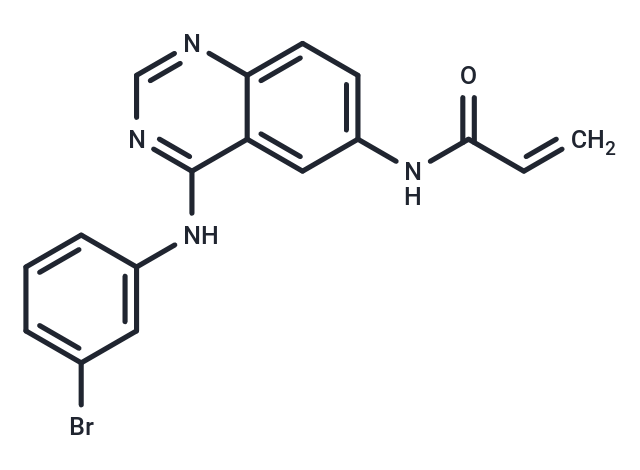Shopping Cart
- Remove All
 Your shopping cart is currently empty
Your shopping cart is currently empty

PD168393 is an irreversible EGFR inhibitor (IC50: 0.70 nM), irreversibly alkylate Cys-773; inactive against PKC, FGFR, PDGFR, and insulin.

| Pack Size | Price | Availability | Quantity |
|---|---|---|---|
| 1 mg | $33 | In Stock | |
| 2 mg | $45 | In Stock | |
| 5 mg | $61 | In Stock | |
| 10 mg | $91 | In Stock | |
| 25 mg | $157 | In Stock | |
| 50 mg | $234 | In Stock | |
| 100 mg | $327 | In Stock | |
| 1 mL x 10 mM (in DMSO) | $51 | In Stock |
| Description | PD168393 is an irreversible EGFR inhibitor (IC50: 0.70 nM), irreversibly alkylate Cys-773; inactive against PKC, FGFR, PDGFR, and insulin. |
| Targets&IC50 | EGFR:0.70 nM |
| In vitro | PD 168393 is docked into the ATP binding pocket of EGFR TK. PD168393 completely suppresses EGF-dependent receptor autophosphorylation in A431 cells during continuous exposure, with continous suppression even after 8 hr in compound-free medium. PD168393 inhibits heregulin-induced tyrosine phosphorylation in MDA-MB-453 cells with IC50 of 5.7 nM. PD168393 is inactive against insulin, PDGF and basic FGFR TKs as well as PKC. PD168393 inhibits EGF-mediated tyrosine phosphorylation in HS-27 human fibroblasts with IC50 of 1-6 nM but has little effect on FGF- or PDGF-mediated tyrosine phosphorylation. [1] PD168393 shows rapid and potent inhibition of Her2-induced tyrosine phosphorylation with IC50 of ~100 nM in 3T3-Her2 cells. D168393 also inhibits phosphorylation of PLCγ1/Stat1/Dok1/δ-catenin in 3T3-Her2 cells, except for Fyb. [2] |
| In vivo | PD 168393 produces tumor growth inhibition of 115% in A431 human epidermoid carcinoma xenograft in nude mice, with 50% reduced phosphotyrosine content of EGFR. PD 168393 also shows a low plasma concentration. [1] |
| Kinase Assay | The effects of VU0364770 on rat mGlu1 and mGlu5 are assessed by using calcium mobilization and measuring the glutamate concentration-response relationship in the presence and absence of 10 μM VU0364770. Using a double-addition protocol, VU0364770 is added to the cells, followed 2.5 min later by a full concentration-response of glutamate. Shifts of the concentration-response relationship are used to assess potential potentiator (left shift of more than 2-fold) or antagonist (right shift of more than 2-fold or depression of the maximum response by at least 75%) activity of VU0364770. Compounds are further assessed for mGlu5 antagonist activity by performing a full concentration-response curve, starting at 30 μM and serially diluted it by using 1:3 dilutions, in the presence of an EC80 concentration of glutamate[1]. |
| Molecular Weight | 369.22 |
| Formula | C17H13BrN4O |
| Cas No. | 194423-15-9 |
| Smiles | Brc1cccc(Nc2ncnc3ccc(NC(=O)C=C)cc23)c1 |
| Relative Density. | 1.558 g/cm3 (Predicted) |
| Storage | Powder: -20°C for 3 years | In solvent: -80°C for 1 year | Shipping with blue ice. | |||||||||||||||||||||||||||||||||||
| Solubility Information | Ethanol: < 1 mg/mL (insoluble or slightly soluble) H2O: < 1 mg/mL (insoluble or slightly soluble) DMSO: 40 mg/mL (108.34 mM) | |||||||||||||||||||||||||||||||||||
Solution Preparation Table | ||||||||||||||||||||||||||||||||||||
DMSO
| ||||||||||||||||||||||||||||||||||||

Copyright © 2015-2024 TargetMol Chemicals Inc. All Rights Reserved.